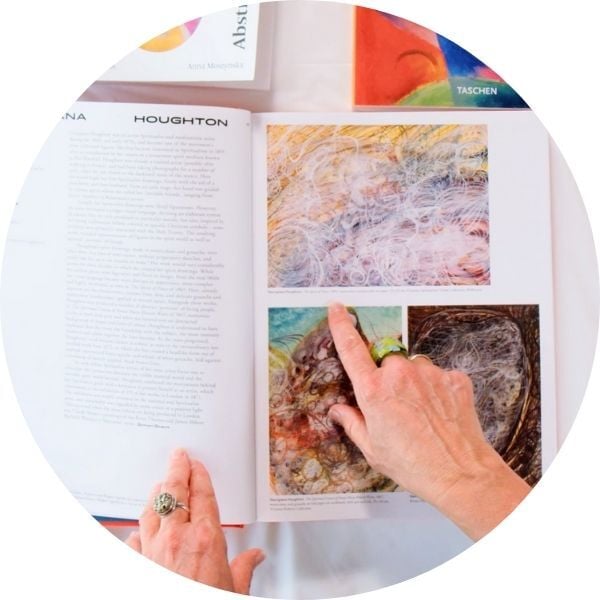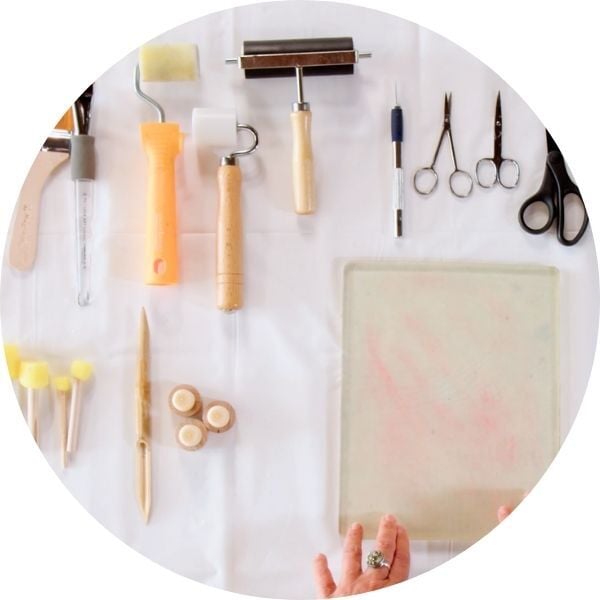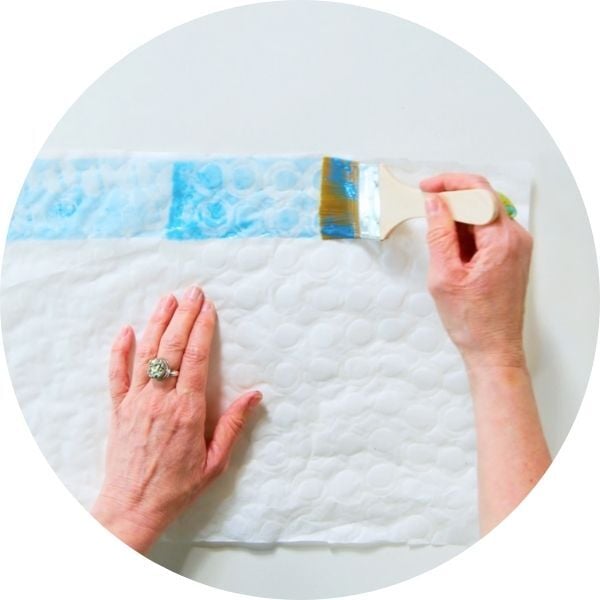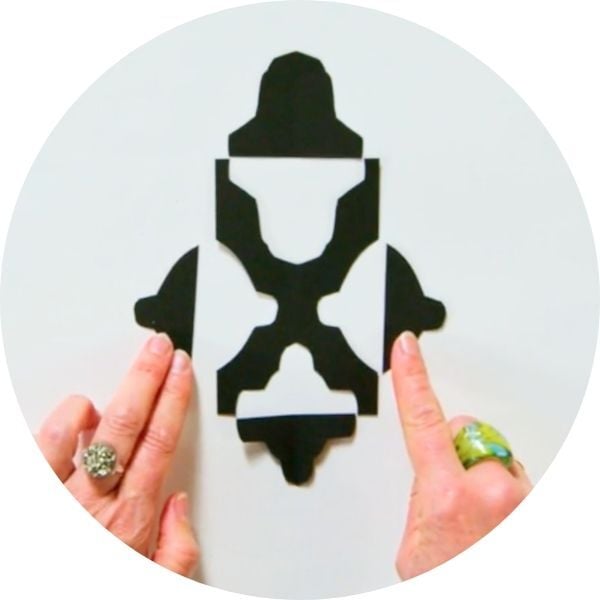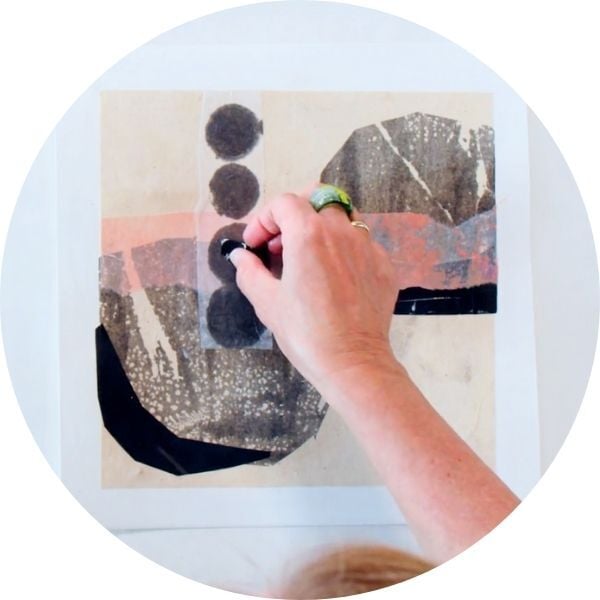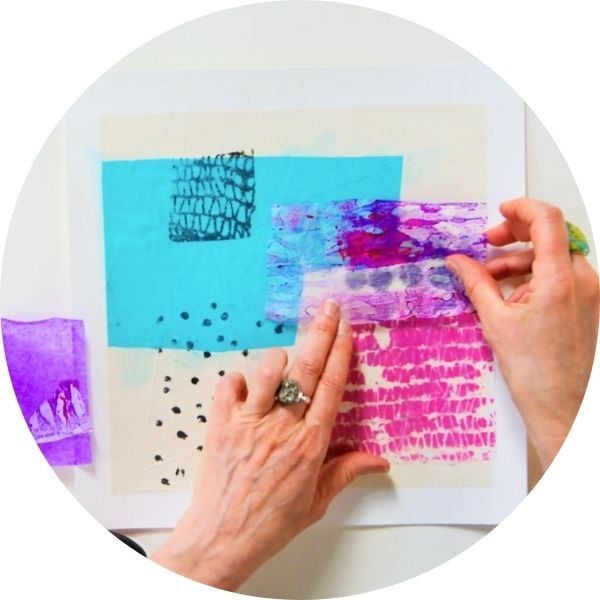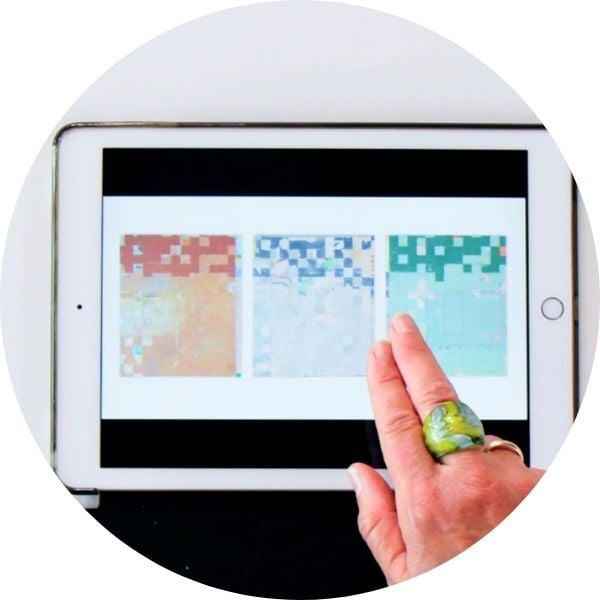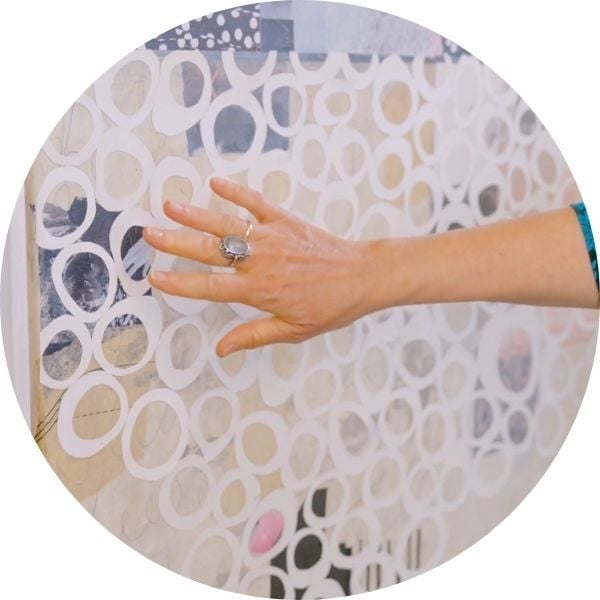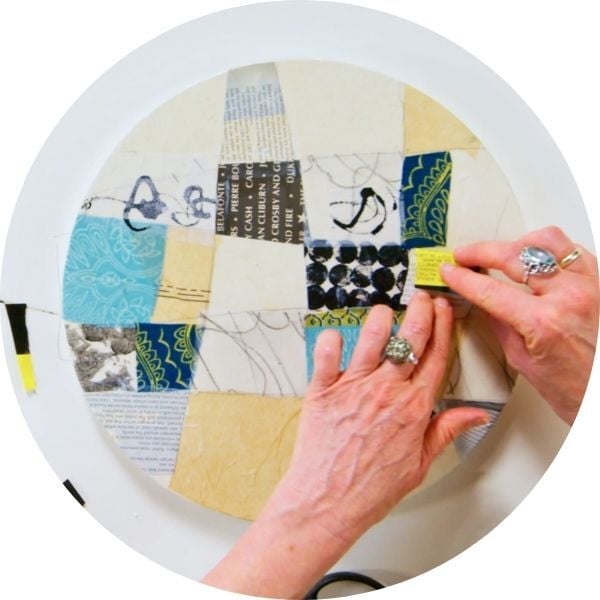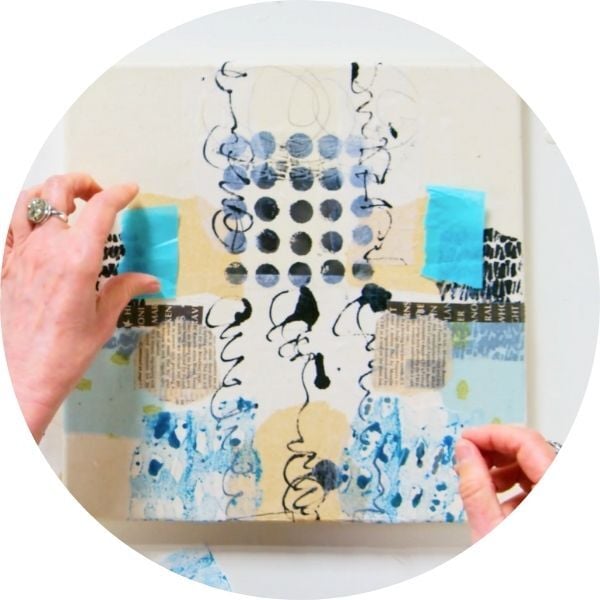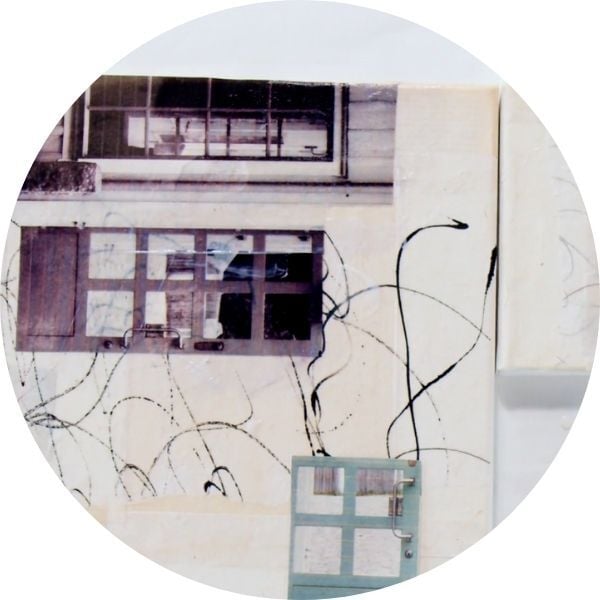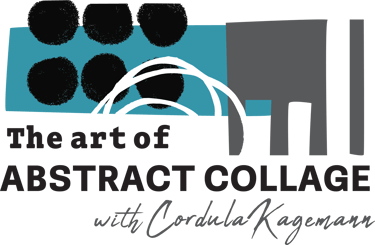
Composition is the backbone of all artwork.
Learn to make abstract art that feels intentional, not accidental.
SELF-PACED | LIFETIME ACCESS | 8 WEEKS TUTOR SUPPORT | PRIVATE ONLINE COMMUNITY
Register your interest in this course.
By subscribing, you consent to receive course updates, our newsletter, and artist features per our Privacy Policy. We will never share or sell your personal information.
In the Art of
Abstract Collage, you’ll:
- Learn the foundations of strong composition so you can confidently create artwork that feels intentional, balanced, complete and compelling.
- Use abstract collage as your creative playground to explore visual rhythm, contrast, space, and harmony.
- Develop an eye for what works - and a knowledge of why it works - with practical tools you can apply across any medium.
- Create abstract works that feel resolved, not random - even when you’re making bold, minimal, or unconventional creative decisions.
- Explore texture, layering, and shape - no matter what materials you're drawn to.
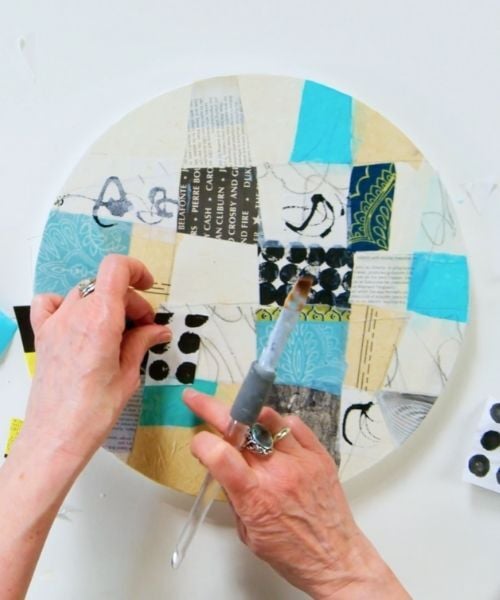
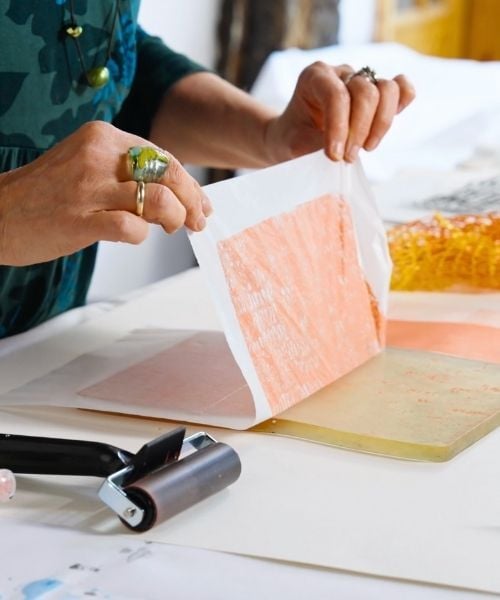



Cordula’s teaching led to a mental “click” in understanding the concepts of composition. This course has taken my collage art to the next level and has added another level of depth and richness to my body of work. I really connected with Cordula’s calm, concise and non-judgmental teaching style. Since the course is self-paced, I never felt anxious about keeping up. Now, I’m more confident in my compositions, and I know artists working in any medium would benefit by wide range of lessons that can be universally applied. Trust me, it’s worth the investment!
- Eva Potter
I have already recommended this course to several friends because it’s truly transformative. Before enrolling in the course, my artistic practice felt somewhat confined, as I primarily worked within familiar themes and techniques. Since then, my perspective has completely transformed - I now embrace new themes with confidence and have discovered exciting ways to create and use my own materials, allowing my art to evolve in unexpected and deeply fulfilling.
- Birgit Kühr
I learned so much from Cordula in this course! I started my abstract art journey about a year ago. As a creative writer and former lawyer, I'm used to expressing myself through words. But actually getting my hands dirty with paint and medium to create physical art that someone can reach out and touch has been thrilling and terrifying and so much more rewarding than I ever imagined. The techniques taught in this course are unique and will bring another layer to anybody's artistic repertoire. Also, even if you think you know about archetypal composition and imagery, studying it with an eye toward creating a work of collage is incredibly interesting and rewarding.
- Diane Gorczyca
It will certainly be an experience which will open up a whole range of possibilities in any form or art. An incredible eye-opening experience. Most of all I appreciate Cordula's generosity in her teaching and the serenity with which she transmits it. My knowledge of design, composition and archetypal elements was somehow limited before I took this course. I have now acquired a lot more confidence and the base from which I can further continue to learn and develop in my art work. Endless opportunities to develop and express our creativity.
- Ana Tièche
I loved Codulas thorough approach and calm, clear delivery very much. As a relatively new artist (4 years) this course has developed my understanding of composition, giving me tools to recognise when a work is complete. Modules were easy to absorb, I wanted to revisit them again and again. It was a breakthrough, the process provided a loose framework to work through the stumbling blocks, finishing with what I consider to be a series of cohesive pieces. The feedback is invaluable- I found the whole experience to be very uplifting.
- Leanne Johnston
Cordula generously shares insights into her working process in such a calm and inspiring way that it makes you want to dive right in! I am still relatively new to working with collages and often found it challenging to determine what steps to take next. In this course, I learned techniques that help me build my collages step by step. The videos are professionally filmed, providing high-quality visuals. The summaries are also excellent—starting each module with clear goals and ending with an overview and practical tips for practice and experimentation. The course fee is absolutely justified given the extensive material provided.
- Martina Grandel
Here's how Cordula delivers her
world-class curriculum...
MODULE 1: Introduction to Abstract Composition

In this module, you will explore...
- Historical Context and Evolution of Abstract Art: Discover how abstract art emerged and evolved, focusing on the groundbreaking work of early 20th-century artists who redefined the visual language of art.
- Understanding Composition: Learn why composition is the backbone of successful abstract art and how it guides the viewer’s eye through an artwork, creating balance, harmony, and emotional impact.
- Cordula’s Artistic Journey: This module will provide insight into Cordula Kagemann's personal experiences and artistic process, setting the tone for a course that emphasises both creative exploration and practical application.
MODULE 2: Tools & Materials
Dive into the practical aspects of abstract collage by exploring the essential tools and materials that will become your creative companions throughout the course. Cordula Kagemann guides you through her selection of papers, adhesives, and tools, offering tips on organising and storing your materials for optimal workflow. This module is designed to equip you with everything you need to start creating, ensuring you feel confident and prepared as you move forward.
You’ll discover...
- Introduction to Collage Materials: Get an overview of the specific papers, adhesives, and tools Cordula uses in her work, with practical advice on selecting the best materials for your projects.
- Organising and Storing Materials: Learn how to efficiently organise and store your collage supplies, making it easier to maintain a productive and inspiring workspace.
- Preparing for Creative Success: Understand the importance of being well-prepared before beginning any art project, setting the foundation for a smooth and enjoyable creative process.

By the end of this module, you’ll be fully equipped with the knowledge and materials needed to embark on your abstract collage journey, setting yourself up for success in the creative exercises to come.
MODULE 3: Design Elements - Preparing Collage Papers

You will explore...
- Creating Collage Papers: Discover how to use different methods to craft unique collage papers that will serve as the foundation for your abstract compositions in upcoming modules.
- Understanding Design Elements: Gain a comprehensive understanding of essential design elements, including dots, lines, marks, shapes, patterns, and textures, and learn how to apply them to create distinctive collage papers.
- Building a Paper Collection: Learn Cordula’s techniques for building an organised collection of patterned and textured papers that will enrich your future collage projects.
MODULE 4: Exploring Notan and the Principle of Balance
In module four, Cordula Kagemann introduces you to the profound Japanese concept of Notan, which focuses on the harmony between dark and light. This module is dedicated to understanding and applying the essential design principle of balance, a cornerstone of successful abstract compositions.
You will learn...
- The Concept of Notan: Discover the significance of Notan, a Japanese principle that emphasises the balance between dark and light elements in art, creating harmony and visual interest in your compositions.
- Practical Exercises in Balance: Engage in hands-on exercises to explore the interplay of shape, form, and placement in achieving balanced compositions.
- Playful Experimentation: Embrace a playful approach as Cordula encourages spontaneous experimentation with shapes and compositions, fostering creativity and deeper insight into the dynamics of balance.

MODULE 5: Mastering Design Principles in Abstract Collage

You'll learn to:
- Apply Rhythm and Movement: Learn to guide the viewer's eye across your collage, creating a dynamic flow and energy that keeps the composition engaging.
- Create Depth and Spatiality: Discover techniques for adding dimension to your work, enhancing the visual impact by creating a sense of depth and space.
- Enhance Emphasis and Focal Points: Understand how to draw attention to key areas within your collage, ensuring certain elements stand out while maintaining overall harmony.
By the end of this module, you will have the skills and confidence to refine your collage studies, making informed decisions that enhance unity and create visually compelling compositions. This module will help you connect and balance visual elements, resulting in cohesive and expressive pieces that resonate with viewers.
MODULE 6: Mastering Colour Contrasts
You’ll discover...
- Fundamental Color Contrasts: Delve into the key contrasts outlined by Johannes Itten, including complementary colours, the contrast of hue, dominance and quantity, quality and value, warm versus cool colours, and colour versus non-colour.
- Application in Collage: Discover how to apply these colour contrasts within the unique context of collage, considering the challenges and opportunities presented by pre-existing materials.
- Techniques for Layering: Experiment with layering techniques to alter and enrich colour effects, adding depth and complexity to your compositions.

MODULE 7: Format - Presentations
In Module 7, Cordula Kagemann delves into the significance of format and its profound impact on abstract art composition. You’ll explore how various formats—landscape rectangles and polyptychs—can shape and influence your artistic expression. By learning about different formats, you’ll discover how they can alter the visual impact and guide compositional choices in your work.

You will explore:
- The Influence of Format: Understand how different formats, such as rectangles, squares, circles, and irregular outlines, affect the composition and perception of abstract art.
- Contemporary Insights: Analyze the works of contemporary collage and mixed media artists to gain insights into how format can enhance or challenge creative intentions.
- Historical Perspectives: Discover how formats have been utilised throughout art history and how they have evolved over time.
By the end of this module, you will have a deeper understanding of how format influences the overall composition and impact of abstract art. With this knowledge, you’ll be equipped to experiment confidently with various formats, enhancing your creative work's visual appeal and depth.
MODULE 8: Surface Design Studies
You’ll uncover:
- Surface Structuring Techniques: Learn methods for structuring your art surfaces, including horizontal and vertical partitions, the golden ratio, and diagonal lines, to create balanced and dynamic compositions.
- Practical Applications: Engage in small studies on canvas boards, using a neutral colour scheme to focus on structure and experiment with different design approaches.
- Strategic Design Planning: Discover the benefits of making design choices upfront, such as utilising the golden ratio or rule of thirds, to guide your intuitive art process and create well-balanced artwork.

MODULE 9: Archetypal Compositions 1

You will learn:
- Understanding Archetypal Forms: Learn about the cross, circle, and grid compositions, three fundamental structures that have been used in art for centuries.
- Integrating Design Elements: Watch as Cordula demonstrates how these archetypal shapes can provide structure without becoming formulaic, applying design elements and principles discussed in earlier modules.
- Practical Application: Create your own compositions using these archetypal structures, integrating materials like vintage magazine papers and fabrics alongside your previously created collage papers.
MODULE 10: Archetypal Compositions 2
You will create...
- The L Shape: Discover how this versatile format can guide the arrangement of elements within your collage, creating balance and focus.
- The Triangle: Learn how the stability and directionality of triangular compositions can add dynamism and structure to your work.
- Symmetrical Composition (The Mirror): Understand the power of symmetry in creating harmonious and reflective compositions that resonate with viewers.

Module one: Introduction to abstract composition.
What makes abstract art feel complete, even without a clear subject? It all starts with composition. In this opening module, Cordula Kagemann introduces you to the foundations of abstract art and the role composition plays in making your work feel balanced, expressive, and complete.
In this module, you’ll:
- Gain historical context for how abstract art developed as a visual language separate from traditional representation.
- Learn why composition is the foundation of strong, cohesive artwork – even in abstract styles.
Discover how artists like Kandinsky and Malevich used form, colour, and shape to communicate emotion. - Go behind the scenes with Cordula’s own artistic journey and discover how her process has evolved over time.
- Lay the groundwork for building your own compositional voice throughout the course.
Module two: Tools and materials.
Next, it’s time to dive into the practical aspects of abstract collage! In this module, Cordula will walk you through the essential tools, papers, and adhesives that will become your creative companions throughout the course, and show you how to set up a workspace that supports greater focus, ease, and creative flow.
In this module, you’ll:
- Explore the essential materials used in abstract collage, including paper types, adhesives, and basic tools. (Check our FAQs for a full list of the recommended supplies you’ll need for this course.)
- Gain practical guidance on selecting and preparing the right materials for you.
- Learn how to organise and store your supplies so your space feels clear, not cluttered, and sets the tone for a smoother creative process.
- Discover how simple setup strategies can set the tone for a smoother creative process
- Be fully equipped with the knowledge and materials needed to embark on the rest of your abstract collage journey.
Module three: Design elements – Preparing collage papers.
The collage papers you create in this module will become the building blocks of your abstract compositions. Using paint, cutting, and mark-making techniques, you’ll explore key design elements and begin developing a rich library of textures, patterns, and visual language to draw from in future modules.
In this module, you’ll:
- Paint, cut, stamp, and layer your way through a series of guided techniques to create textured, expressive collage papers.
- Explore essential design elements like line, shape, pattern, and texture.
- Experiment with mark-making to bring depth and variation to your work.
- Build a collection of papers that reflect your style and support your compositions.
Module four: Exploring Notan and the principle of balance.
In this module you’ll explore the Japanese concept of Notan and learn how the relationship between dark and light creates visual balance in your compositions. With Cordula’s guidance, you’ll experiment with simple shapes and high-contrast studies to build stronger, more cohesive compositions from the ground up.
In this module, you’ll:
- Learn about the principle of Notan and how light and dark shape visual balance.
- Create high-contrast paper studies that explore positive and negative space.
- Practise layering, placement, and proportion to strengthen your compositions.
- Learn to trust your eye through hands-on experimentation and playful exercises with cut shapes and collage.
- Explore balance not just as a visual tool, but as a creative mindset that can support both your art and everyday life.
Module five: Mastering design principles in abstract collage.
- Use rhythm and movement to create flow and energy across the surface.
- Add depth and dimension through layering and spatial contrast.
- Create emphasis by drawing attention to key areas of your collage.
- Refine your compositions so every element feels connected and intentional.
- Build on your Notan studies and develop the skills to make informed visual decisions with greater confidence.
Module six: Mastering colour contrasts.
- Explore essential colour contrasts including hue, temperature, saturation, and value.
- Learn how to use complementary and opposing colours to create harmony and tension in your artwork.
- Apply colour theory within the practical limits of collage materials.
- Experiment with layering techniques to shift and enrich colour relationships.
- Use colour not just decoratively, but as a structural tool in your compositions.
Module seven: Format – Presentations.
- Learn how format affects structure, movement, and spatial balance.
- Experiment with rectangles, squares, circles, and irregular shapes.
- Study how format can support or challenge your creative intent.
- Explore examples from contemporary and historical artists working in collage and mixed media.
- Start making intentional choices about format that strengthen your overall composition.
Module eight: Surface design studies.
- Learn how to structure your surface using lines, grids, and compositional guides.
- Apply design systems like the golden ratio and rule of thirds to guide your layout decisions.
- Create small studies on canvas boards that focus on structure using a limited, neutral palette.
- See how thoughtful planning can support - not restrict - your intuitive process.
- Build the confidence to start your next piece with intention, not hesitation.
Module nine: Archetypal compositions 1.
- Learn the history and function of cross, circle, and grid compositions, three fundamental structures that have been used in art for centuries.
- Watch as Cordula demonstrates how these archetypal shapes can provide structure without becoming formulaic.
- Apply design elements learned from earlier modules within each layout.
- Create your own compositions using these archetypal structures, integrating materials like vintage papers, fabric, and your custom collage papers.
Module ten: Archetypal compositions 2.
- Create a collage using the L shape to lead the eye and anchor your composition.
- Use a triangle format to introduce direction, stability, and movement.
- Explore symmetrical composition to create balance, harmony, and visual reflection.
- Combine materials and techniques from earlier modules to complete three final artworks.
- Strengthen your ability to choose the right format for the feeling you want to create.
Bonus module: Abstraction of a memory.
- Select and prepare personal imagery as source material for abstraction.
- Explore how memory can shape form, texture, and composition.
- Create a diptych that reflects a personal story through abstract expression.
- Learn how to use photographic fragments as emotional and visual anchors.
- Integrate symbolic and biographical elements to deepen your creative voice.
Sign up for exclusive course previews and updates
When you register your interest in The Art of Abstract Collage:
✔️ When it gets closer to enrolment opening, you'll unlock a special five-part video series where you’ll get to know Cordula, and hear her thoughts on abstract vs representational art and overcoming blank canvas syndrome.
✔️ In this five-part series you'll experience a hands-on tutorial with Cordula straight from her studio and enjoy behind-the-scenes sneak peeks of The Art of Abstract Collage before it opens for enrolment.
✔️ You'll be notified when enrolment opens so you can secure your spot.
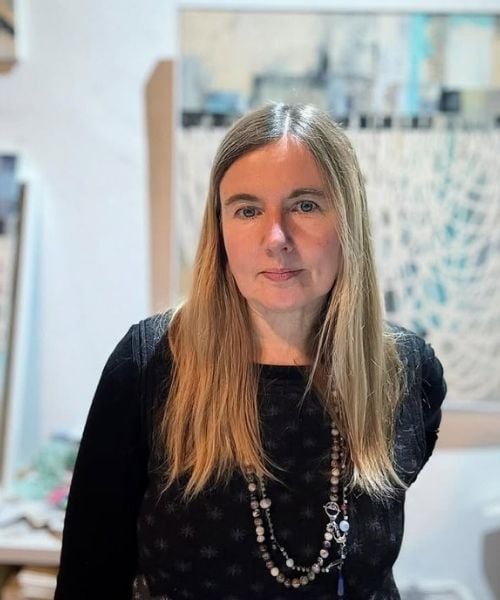
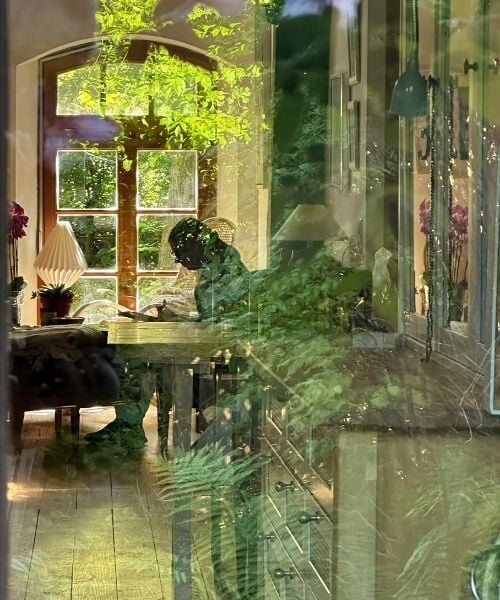


Meet your tutor
Tucked away in a 300-year-old farmhouse in the German countryside, Cordula Kagemann is a mixed media artist with a background in textiles, fashion, and visual arts.
For Cordula, composition is less about rigid rules and more about clarity. It’s a way of creating flow, anchoring emotion, and building visual trust. She believes that when you understand the building blocks - balance, rhythm, focal point, contrast - you stop second-guessing and start creating with intention.
As a teacher, Cordula is calm, clear, and generous - a guide more than an instructor. She teaches from experience, drawing on decades of creative practice and a lifelong fascination with composition. Her approach helps you combine intuition with structure to develop a visual language that feels fully your own.
Helpful FAQs
Have another question? We’re here to help! Please contact the Take Two team at support@fibreartstaketwo.com
-
Enrolment for 2025 closed in June. Register your interest to be notified when enrolement opens again!
-
Not at all. This course was created for creatives who want to watch in their own time, hit pause, re-watch, take a break, and then return for more!
While you will receive live support during the first eight weeks of enrolment, there is no set schedule to complete this course. Plus, you’ll have all the material for life!
“Before the pandemic I could not have imagined an online art course but now I am a complete convert. I think the freedom to take your time and disappear down your own rabbit hole is such a joy!” Wendy G -
Below is a list of the tools Cordula uses in her art practice and collage techniques during the course. We always recommend using your existing tools and supplies before purchasing new materials:
- Splatter brush (or an old toothbrush)
- Synthetic brush (soft hair)
- Foam stamping brushes
- Paint brayer
- Foam roller (old is best)
- Reed or bamboo pen
- Feather
- Corks and foam craft sheets (for handmade stamps)
- Japanese scraper (or paint scraper)
- Q-tips (cotton swabs)
- Netting or fabric with large holes (example: onion or potato packaging)
- Titanium paper scissors
- Small sharp paper or nail scissors
- Cutting knife (X-acto) and mat
- Small plexiglass or glass plate
- Gel plate
- Spray/mist bottle for water
- Trays or plates for paint and water
- Acrylic paints - all colours (consider using what you have on hand)
- Acrylic ink
- Acrylic medium
- Paint pens
- Pencils and graphite sticks
- Papers (anything you already have in your stash like gift wrapping papers, photographs, tickets, book pages, old personal letters, as well as white and coloured tissue paper, lokta paper, rice paper, drawing paper, and black paper)
- Mixed media sketchbook
- Canvas art boards
-
At this stage, we choose to host our student community groups on Facebook as it’s a free, accessible platform that allows ease of communication for both students and tutors.
To ensure an inclusive experience, we live stream our Q&A sessions through YouTube and send regular updates via email for those unable to create a Facebook account.
We also have multiple moderators actively engaged within the group to ensure our communities remain safe and welcoming learning environments.
This community is not compulsory, but it’s highly recommended - and our students love it!
“FATT have put together this fabulous format that nurtures the interactions among us. I didn’t even do Facebook before!” – Chris Carlson
-
That’s okay - you don’t need to be a tech whiz to enjoy our online fibre art courses!
Our students regularly report (with much relief 😉) how easy it is to use our online learning platform. We’re also proudly well-known for our top-notch customer service and are always just a message away if you need support.
-
Absolutely. Our course content is fully responsive, so you can access your course wherever you feel most comfortable - your computer, phone, or tablet. All you need is an internet connection.
-
Because we have students from all around the world, we have set up geolocation to accommodate your local currency where we can. We currently accept USD, AUD, GBP, Euro, CAD and NZD… with more to come! If your currency wasn’t mentioned, your bank will still automatically convert it to your local currency once the charge goes through.
(And on the topic of being international, the Take Two team are based in Australia… hence the spelling of things like fibre, realise and enrol!) -
Great question. You can post your questions about the course in our private Facebook group; either someone from the community, Take Two or Cordula herself can help you.
If you have more technical questions or are unable to join the student group, please don’t hesitate to contact support@fibreartstaketwo.com.
“I am so glad I found FATT. Everything is so well put together and the support is wonderful.” Jeniffer H
Be informed - and inspired! - about this course.
By subscribing, you consent to receive updates about this course, our newsletter, and artist features per our Privacy Policy. We will never share or sell your personal information.
Not the course you're looking for?
Take a look at the other online art courses we have available!

